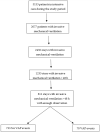Clinical Decision Support System to Detect the Occurrence of Ventilator-Associated Pneumonia in Pediatric Intensive Care
- PMID: 37761350
- PMCID: PMC10528404
- DOI: 10.3390/diagnostics13182983
Clinical Decision Support System to Detect the Occurrence of Ventilator-Associated Pneumonia in Pediatric Intensive Care
Abstract
Objectives: Ventilator-associated pneumonia (VAP) is a severe care-related disease. The Centers for Disease Control defined the diagnosis criteria; however, the pediatric criteria are mainly subjective and retrospective. Clinical decision support systems have recently been developed in healthcare to help the physician to be more accurate for the early detection of severe pathology. We aimed at developing a predictive model to provide early diagnosis of VAP at the bedside in a pediatric intensive care unit (PICU).
Methods: We performed a retrospective single-center study at a tertiary-care pediatric teaching hospital. All patients treated by invasive mechanical ventilation between September 2013 and October 2019 were included. Data were collected in the PICU electronic medical record and high-resolution research database. Development of the clinical decision support was then performed using open-access R software (Version 3.6.1®).
Measurements and main results: In total, 2077 children were mechanically ventilated. We identified 827 episodes with almost 48 h of mechanical invasive ventilation and 77 patients who suffered from at least one VAP event. We split our database at the patient level in a training set of 461 patients free of VAP and 45 patients with VAP and in a testing set of 199 patients free of VAP and 20 patients with VAP. The Imbalanced Random Forest model was considered as the best fit with an area under the ROC curve from fitting the Imbalanced Random Forest model on the testing set being 0.82 (95% CI: (0.71, 0.93)). An optimal threshold of 0.41 gave a sensitivity of 79.7% and a specificity of 72.7%, with a positive predictive value (PPV) of 9% and a negative predictive value of 99%, and with an accuracy of 79.5% (95% CI: (0.77, 0.82)).
Conclusions: Using machine learning, we developed a clinical predictive algorithm based on clinical data stored prospectively in a database. The next step will be to implement the algorithm in PICUs to provide early, automatic detection of ventilator-associated pneumonia.
Keywords: PICU; clinical decision system; pneumonia; ventilator associated.
Conflict of interest statement
The authors declare no conflict of interest.
Figures




Similar articles
-
Diagnosis of ventilator-associated pneumonia using electronic nose sensor array signals: solutions to improve the application of machine learning in respiratory research.Respir Res. 2020 Feb 7;21(1):45. doi: 10.1186/s12931-020-1285-6. Respir Res. 2020. PMID: 32033607 Free PMC article.
-
Ventilator Associated Pneumonia in Pediatric Intensive Care Unit: Incidence, Risk Factors and Etiological Agents.Indian J Pediatr. 2018 Oct;85(10):861-866. doi: 10.1007/s12098-018-2662-8. Epub 2018 Apr 4. Indian J Pediatr. 2018. PMID: 29616405 Free PMC article.
-
National nosocomial infection surveillance system: from benchmark to bedside in trauma patients.J Trauma. 2006 Jan;60(1):98-103. doi: 10.1097/01.ta.0000196379.74305.e4. J Trauma. 2006. PMID: 16456442
-
Incidence of Ventilator-Associated Pneumonia in Critically Ill Children Undergoing Mechanical Ventilation in Pediatric Intensive Care Unit.Children (Basel). 2017 Jul 3;4(7):56. doi: 10.3390/children4070056. Children (Basel). 2017. PMID: 28671616 Free PMC article.
-
Probiotic Supplementation Prevents the Development of Ventilator-Associated Pneumonia for Mechanically Ventilated ICU Patients: A Systematic Review and Network Meta-analysis of Randomized Controlled Trials.Front Nutr. 2022 Jul 8;9:919156. doi: 10.3389/fnut.2022.919156. eCollection 2022. Front Nutr. 2022. PMID: 35879981 Free PMC article.
Cited by
-
Data Representation Structure to Support Clinical Decision-Making in the Pediatric Intensive Care Unit: Interview Study and Preliminary Decision Support Interface Design.JMIR Form Res. 2024 Feb 1;8:e49497. doi: 10.2196/49497. JMIR Form Res. 2024. PMID: 38300695 Free PMC article.
-
Ventilator-Associated Pneumonia Prediction Models Based on AI: Scoping Review.JMIR Med Inform. 2024 May 14;12:e57026. doi: 10.2196/57026. JMIR Med Inform. 2024. PMID: 38771220 Free PMC article.
References
-
- Center for Disease Control. [(accessed on 14 September 2023)];2018 Available online: https://www.cdc.gov/nhsn/PDFs/pscManual/6pscVAPcurrent.pdf.
-
- Gutiérrez J.M.M., Borromeo A.R., Dueño A.L., Paragas E.D., Ellasus R.O., Abalos-Fabia R.S., Abriam J.A., Sonido A.E., Hernandez M.A., Generale A.J.A., et al. Clinical epidemiology and outcomes of ventilator-associated pneumonia in critically ill adult patients: Protocol for a large-scale systematic review and planned meta-analysis. Syst. Rev. 2019;8:180. doi: 10.1186/s13643-019-1080-y. - DOI - PMC - PubMed
LinkOut - more resources
Full Text Sources

